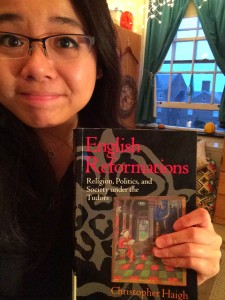Haigh, Christopher. “Chapter 6: Divorce, Supremacy, and Schism, 1530-1535.” English Reformations: Religion, Politics, and Society under the Tudors. Oxford: Clarendon, 1993. 105-21. Print.
After we learned about the Protestant Reformation in class, I was intrigued as to how King Henry VIII of England could garner enough support from his fellow elite and clergy to break from the Roman Catholic Church and create the Church of England in 1534. The King’s intention of marrying Anne Boleyn, while he was still legally bound to Catherine of Aragon, spurred him so far to establish himself as the head of both Church and State in England. I wondered whether King Henry VIII also had political motivation to create schism in the Christian faith. As a result, for this assignment I searched the online Skillman Library catalogue for “Henry VIII Church” to find books on this rift. The first and second returns Henry VIII: Court, Church, and Conflict by David Loades and The King’s Reformation: Henry VIII and the Remaking of the English Church by G.W. Bernard respectively caught my eye – so I went to the stacks to take a look.
When I arrived at the right shelf, I noticed that neither of the two books had covers and were quite plain in color. I scanned the rest of the shelf and noticed English Reformations: Religion, Politics, and Society under the Tudors by Christopher Haigh, which had a painted depiction of a figure, resembling Henry VIII, reading the Bible as the cover. Although the title indicated that the text would not purely focus on King Henry VIII, I believed that it would give good background information on the religious and political turmoil in England during the 1530s. When I looked at the table of contents, I found that Chapter 5 gave insight into the politics of English Parliament at the time, while Chapter 6 focused upon the actual division from the Catholic Church. The latter chapter proved to be more interesting.
Author Haigh, in Chapter 6 exemplified the frustration of both King Henry VIII as well as his religious adversaries during the initial request for divorce. Haigh also explained that at first King Henry the VII had not intended to reform the Church. Instead, he merely wished for dissolution of marriage, which was not granted by the Pope. As a result, King Henry VIII’s advisors gave him conflicting guidance. Some were adamant on adhering to Roman Papal decrees while others, such as Thomas Cromwell, “proposed to ignore Rome and seek a dissolution from an English Court under parliamentary authority” (105). Perhaps, King Henry VIII’s decision to circumvent the authority of the Catholic Church provoked the schism, which allowed for a reformation of the Christian faith.
I plan on continuing to read the rest of this book for my paper on the causes for the English Reformation period under King Henry VIII as well as its legacy. I will also include information from the two books I found first (as stated above) to create a more rounded paper.

